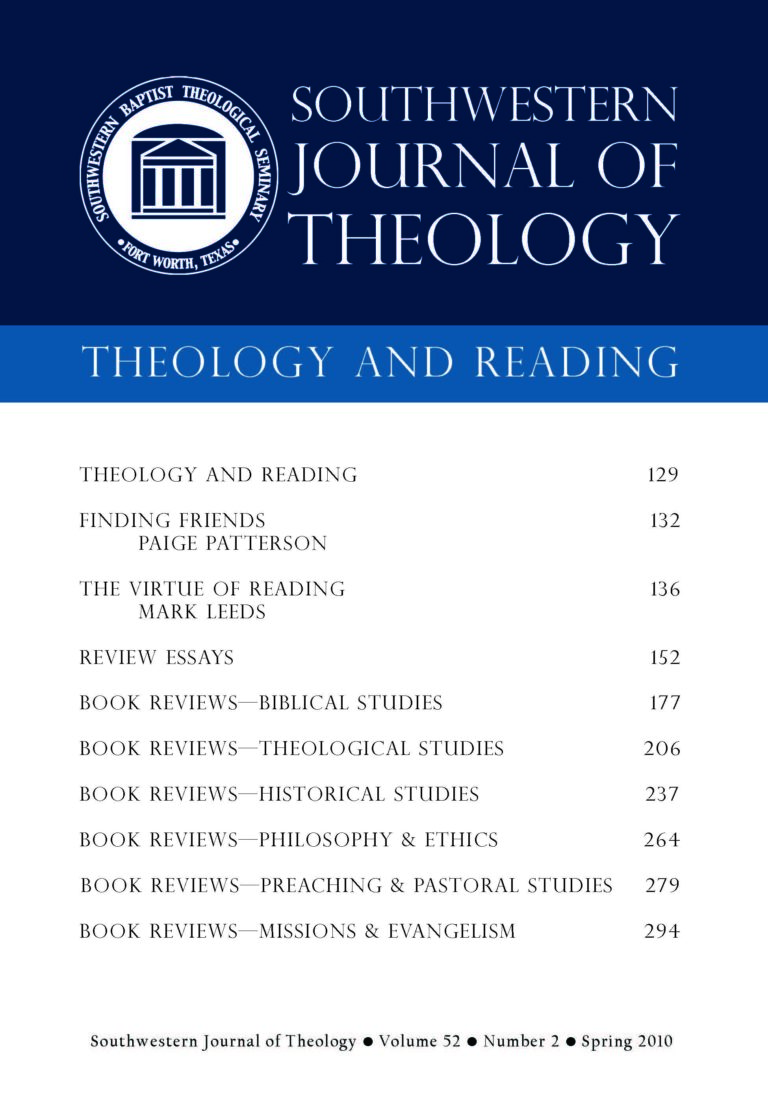
Theology and Reading
Southwestern Journal of Theology
Volume 52, No. 2 – Spring 2010
Managing Editor: Malcolm B. Yarnell III
By Mark Wilson. Grand Rapids: Kregel, 2007. 134 pages. Softcover, $21.99.
Is it possible that a book of charts can aid in the understanding of Scripture? From beginning to end John’s vision recorded in the book of Revelation offers numerous interpretive challenges. With his addition to the Kregel Charts of the Bible and Theology series, Mark Wilson seeks to help with these challenges. Charts on the Book of Revelation includes seventy-nine useful tools. Most of the tools are in fact charts, but he does include several timelines and maps as well. At the end of the work, Wilson includes two sections that give insight to the formation of the charts in the book (119–34). The first is a section citing what resources and tools that Wilson accessed in creating each chart. These resources range from articles that he himself published in the past to historical surveys and monographs to existing charts upon which Wilson builds his work. The second section that Wilson includes is a comprehensive bibliography, which, in essence, includes those sources mentioned in the first section.
There are several notable strengths deserving mention. The subtitle of the book may at first seem a bit strange when considering that the primary content of the book is in the format of charts. How can a book of charts shed light on literary, historical, and theological perspectives of the book of Revelation? Instead of centering on apocalyptic end time debates, which is probably the first thing that comes to mind when encountering a book entitled Charts on the Book of Revelation, Wilson focuses on the literary features of the book of Revelation. In combination with the fact that many of the charts involve the relationship between texts within Revelation and those in other parts of Scripture, this places the book in its proper historical and theological setting. In addition to the normal topics of hermeneutical inquiry into any book of the Bible such as authorship (13), dating (14), setting (15–17), and structure (31), and the expected eschatological topics such as the rapture (70), Armageddon (98), and the millennium (100), Wilson’s work includes charts covering the words which occur only in the book of Revelation (22–24), the symbolism of colors (49), epithets of Jesus with Old and New Testament background (61), the four living creatures (72), and the portrait of the beast (88–89). The most intriguing charts, and perhaps the most beneficial, include allusions and verbal parallels in the Old Testament and extra-biblical literature (25–30; the longest chart in the work), the use of numbers and the symbolism of colors and numbers (47–49), and the thematic parallels between Genesis 1–3 and Revelation (108). Another strength of the book is the level of interaction that the writer has with other well-known works. The result is a useful reference work based upon the best available, highest quality research that has been done on the book of Revelation. A final strength is that the work is designed so that all charts are reproducible for classroom use. While many of the charts are longer than one page, each chart begins on its own page, making it easy to photocopy each chart without having to cut out parts of the previous chart or the chart that follows.
Two weaknesses, while somewhat trivial in degree, should be mentioned. First, there is no way to navigate to a certain chart that contains the desired information other than looking at the seventy-nine individual chart titles in the table of contents. It would be beneficial to the reader if the charts were categorized in some way as to limit this search as much as possible. Second, it would be helpful if the publisher allowed a small paragraph to introduce each chart, summarizing its contents. In some of the charts some readers may wonder exactly what the vertical and horizontal headings are referencing. A short introduction would enable those who are novices in studying Revelation to benefit more from the work. In spite of these weaknesses, Charts on the Book of Revelation would be a worthwhile and useful tool both for the pastor and for the teacher. Alongside solid commentaries and exegetical studies on the book of Revelation, Wilson’s work will help all Bible readers better understand and interpret what is seen by many as one of the most difficult books of the Bible.





